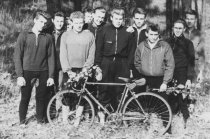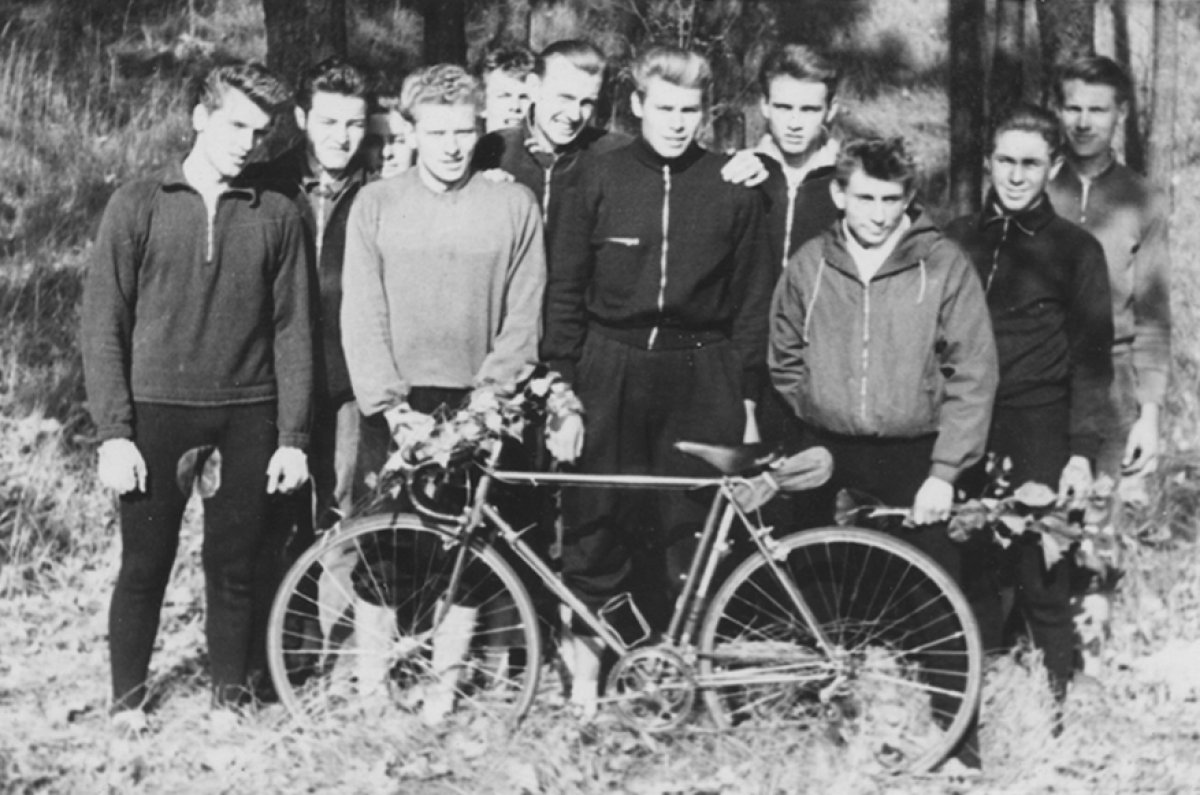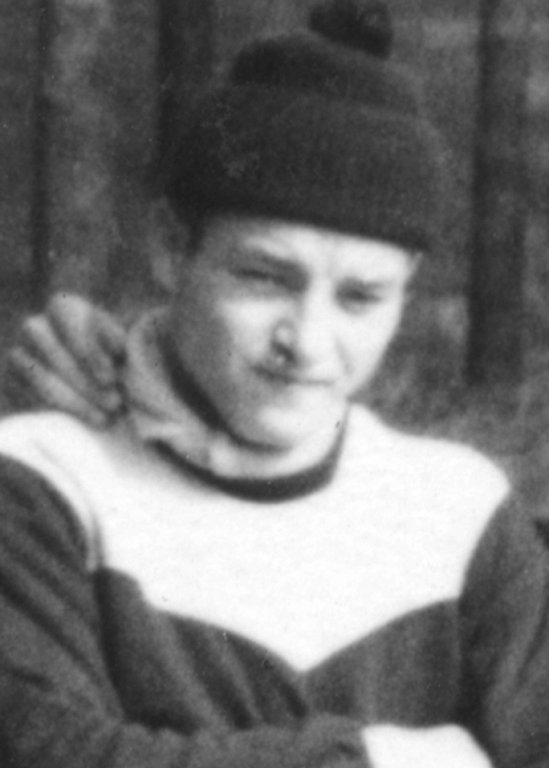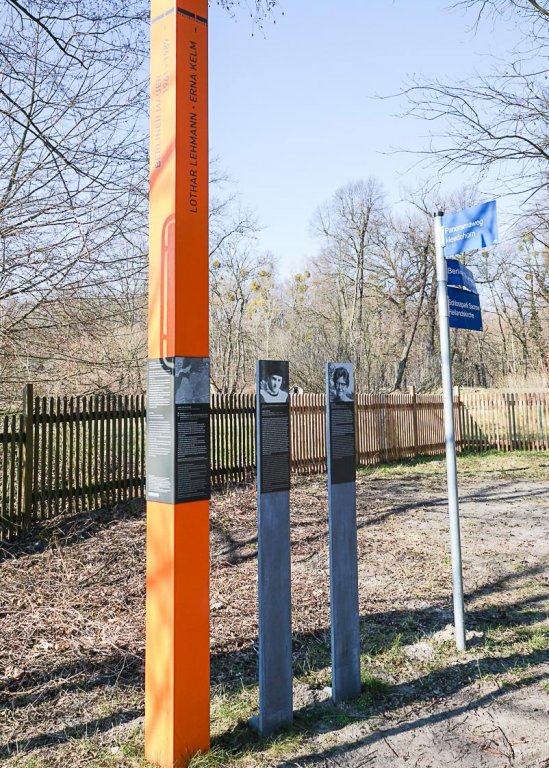born on January 28, 1942
drowned on November 26, 1961
in the Havel River
on the outer ring between Sacrow (Potsdam city district) and Berlin-Zehlendorf
Lothar Lehmann was sent to the border. He was assigned to a Gross Glienicke police unit that was stationed outside of Berlin, not far from his home in Falkensee. His unit belonged to the "border police" that guarded the border between the East German district of Potsdam and West Berlin. Just what motivated the 19-year-old to flee is not known.Lothar Lehmann was 19 years old when he lost his life trying to flee to West Berlin in November 1961. Only pieces of his life and the circumstances of his death are documented. According to official documents, he was born on January 28 or 29, 1942. Contradictory information also exists concerning his place of birth. [1] Thus, it remains unclear whether Lothar Lehmann came from East Prussia or was born in Falkensee, a community outside of Berlin that borders the West Berlin district of Spandau, where he grew up in the care of foster parents and where he attended school in the 1950s. After completing 8th grade he trained to become a metalworker at the state-owned agricultural machine-building company in Falkensee. He spent his free time breeding pigeons and cycling with a local company athletics group. [2]
 In September 1961, a few weeks after the Wall was built, the 19-year-old began his military service. There was no general conscription at this time, hence his enrollment was – technically speaking – voluntary. In truth, however, a major propaganda campaign strongly pressured most young men to commit themselves to an "honor service" for the ‘Socialist Fatherland.’ This pressure increased considerably after the Wall was built. The FDJ, the Communist Party youth organization, began a national campaign in August 1961 under the motto: "The Fatherland is calling! Protect the Socialist Republic!" [3] Its aim was to recruit as many young people as possible into the military to provide the necessary reinforcements for police and army units assigned to "border security."
In September 1961, a few weeks after the Wall was built, the 19-year-old began his military service. There was no general conscription at this time, hence his enrollment was – technically speaking – voluntary. In truth, however, a major propaganda campaign strongly pressured most young men to commit themselves to an "honor service" for the ‘Socialist Fatherland.’ This pressure increased considerably after the Wall was built. The FDJ, the Communist Party youth organization, began a national campaign in August 1961 under the motto: "The Fatherland is calling! Protect the Socialist Republic!" [3] Its aim was to recruit as many young people as possible into the military to provide the necessary reinforcements for police and army units assigned to "border security."
Lothar Lehmann was sent to the border. He was assigned to a Gross Glienicke police unit that was stationed outside of Berlin, not far from his home in Falkensee. His unit belonged to the "border police" that guarded the border between the East German district of Potsdam and West Berlin. Just what motivated the 19-year-old to flee is not known. It does not appear to have been a spontaneous decision. In early November he had let his mother know that he wanted to flee to the West. While on vacation he casually asked her for the address of relatives living in West Germany, remarking: "Won’t they be surprised when I get there." When she worriedly pointed out to him that people were shot at the border, he acted sure of himself, saying things would be fine. [4]
A number of police officers, soldiers and army conscripts like Lothar Lehmann decided to desert during the first weeks and months after the Wall was built, despite the fact that drastic punishments awaited them if they were caught. [5] Guard duty on the border grounds offered advantageous opportunities to escape. Moreover, many of the border guards rejected the intensified barrier measures and feared that they might one day have to shoot at fugitives themselves. In this early period, East German border guards who had deserted were reporting to the West Berlin authorities daily. [6] Lothar Lehmann, however, was unlucky. He died trying to escape without anyone in West Berlin even noticing.
This happened at the bank of the Havel River in Sacrow near Potsdam, an area Lothar Lehmann knew well from his bike training trips. [7] The border to the West Berlin district of Zehlendorf ran through the middle of the river. On November 26, 1961, Lothar Lehmann, a member of his unit’s boating group, was in charge of repairing boats on the Havel riverbank in Sacrow. As evening approached, and when no one was looking, he entered the water wearing a life jacket with the intention of swimming to the other side. Evidently the water was so cold that he suffered a physical shock and lost consciousness. Border guards saw him in this condition, pulled him out of the water and brought him to the Potsdam District Hospital. According to a report from the East Berlin commander, Lothar Lehmann died "around 9 p.m. despite attempts to revive him and without external influences during the arrest and transport." [8] The autopsy conducted later determined that "indirect drowning caused by cold shock and cardiovascular collapse" was the cause of death. [9] These facts were confirmed by an investigation that was conducted as part of the legal prosecution of injustices committed in East Germany in the 1990s. [10]
Lothar Lehmann’s mother put down on record in 1992 that his parents had learned from members of the border police on November 26 that their son had drowned while trying to desert. [11] Over the following days they were questioned about his reasons for fleeing and his escape plans, during which time their son was presented to them as a criminal. The mother did not admit to having known about his plans out of fear that she would be accused of being an accomplice in his "flight from the republic." The East German authorities insisted that the parents not speak to anyone about the escape attempt. At the victim’s funeral in the municipal cemetery in Falkensee, his death had to be referred to as an "accident."
Lothar Lehmann’s friend, Wolfgang S., however, had a hard time believing the official version of the story, particularly since behind closed doors rumors were spreading in the town. According to his own statements, he tried to find out the truth by engaging in a conversation with two border police officers. He learned from them "that Lothar wanted to flee and that he went into the water wearing a life vest. He lost his life doing so, they told me. But they evaded answering my questions about the incident." [12] After that he started asking around in Sacrow and found out where the incident had occurred. Wolfang S. succeeded in fleeing to West Berlin in January 1962 and informed the authorities there of everything he knew about his friend. Lothar Lehmann has been officially registered in the West as a victim of the Wall ever since. [13]
Christine Brecht

Lothar Lehmann (second from left): Posing with fellow bikers of the sports group BSG Lok Elstal (photo: April 1959) (Photo: private)
Lothar Lehmann was sent to the border. He was assigned to a Gross Glienicke police unit that was stationed outside of Berlin, not far from his home in Falkensee. His unit belonged to the "border police" that guarded the border between the East German district of Potsdam and West Berlin. Just what motivated the 19-year-old to flee is not known. It does not appear to have been a spontaneous decision. In early November he had let his mother know that he wanted to flee to the West. While on vacation he casually asked her for the address of relatives living in West Germany, remarking: "Won’t they be surprised when I get there." When she worriedly pointed out to him that people were shot at the border, he acted sure of himself, saying things would be fine. [4]
A number of police officers, soldiers and army conscripts like Lothar Lehmann decided to desert during the first weeks and months after the Wall was built, despite the fact that drastic punishments awaited them if they were caught. [5] Guard duty on the border grounds offered advantageous opportunities to escape. Moreover, many of the border guards rejected the intensified barrier measures and feared that they might one day have to shoot at fugitives themselves. In this early period, East German border guards who had deserted were reporting to the West Berlin authorities daily. [6] Lothar Lehmann, however, was unlucky. He died trying to escape without anyone in West Berlin even noticing.
This happened at the bank of the Havel River in Sacrow near Potsdam, an area Lothar Lehmann knew well from his bike training trips. [7] The border to the West Berlin district of Zehlendorf ran through the middle of the river. On November 26, 1961, Lothar Lehmann, a member of his unit’s boating group, was in charge of repairing boats on the Havel riverbank in Sacrow. As evening approached, and when no one was looking, he entered the water wearing a life jacket with the intention of swimming to the other side. Evidently the water was so cold that he suffered a physical shock and lost consciousness. Border guards saw him in this condition, pulled him out of the water and brought him to the Potsdam District Hospital. According to a report from the East Berlin commander, Lothar Lehmann died "around 9 p.m. despite attempts to revive him and without external influences during the arrest and transport." [8] The autopsy conducted later determined that "indirect drowning caused by cold shock and cardiovascular collapse" was the cause of death. [9] These facts were confirmed by an investigation that was conducted as part of the legal prosecution of injustices committed in East Germany in the 1990s. [10]
Lothar Lehmann’s mother put down on record in 1992 that his parents had learned from members of the border police on November 26 that their son had drowned while trying to desert. [11] Over the following days they were questioned about his reasons for fleeing and his escape plans, during which time their son was presented to them as a criminal. The mother did not admit to having known about his plans out of fear that she would be accused of being an accomplice in his "flight from the republic." The East German authorities insisted that the parents not speak to anyone about the escape attempt. At the victim’s funeral in the municipal cemetery in Falkensee, his death had to be referred to as an "accident."
Lothar Lehmann’s friend, Wolfgang S., however, had a hard time believing the official version of the story, particularly since behind closed doors rumors were spreading in the town. According to his own statements, he tried to find out the truth by engaging in a conversation with two border police officers. He learned from them "that Lothar wanted to flee and that he went into the water wearing a life vest. He lost his life doing so, they told me. But they evaded answering my questions about the incident." [12] After that he started asking around in Sacrow and found out where the incident had occurred. Wolfang S. succeeded in fleeing to West Berlin in January 1962 and informed the authorities there of everything he knew about his friend. Lothar Lehmann has been officially registered in the West as a victim of the Wall ever since. [13]
Christine Brecht
[1]
See "Niederschrift der Zeugenvernehmung eines Freundes von Lothar Lehmann durch die West-Berliner Polizei," in: StA Berlin, Az. 2 Js 137/91, Bl. 15; "Strafanzeige der Berliner Polizei wegen Totschlags von Lothar Lehmann gegen Unbekannt von Amts wegen, 30.1.1992," in: Ibid., Bl. 123a; "Vermerk der Berliner Polizei zum Tod von Lothar Lehmann, 5.2.1992," in: Ibid., Bl. 139.
[2]
See conversations conducted by Maria Nooke with Manfred G., Lothar Lehmann’s fellow sportsman, 26.6.2008 and 16.7.2008, and "Niederschrift der Zeugenvernehmung eines Freundes von Lothar Lehmann durch die West-Berliner Polizei, 23.5.1962," in: StA Berlin, Az. 2 Js 137/91, Bl. 15–20.
[3]
See "Aufruf der FDJ, 18.8.1961," in: BArch, DY 30/IV 2/12/55, Bl. 130.
[4]
Transcript of the Falkensee police witness hearing of Lothar Lehmann’s mother, 21.1.1992, in: StA Berlin, Az. 2 Js 137/91, Bl. 125–128, here Bl. 126.
[5]
See Rüdiger Wenzke (ed.), Staatsfeinde in Uniform. Widerständiges Verhalten und politische Verfolgung in der NVA, Berlin, 2005.
[6]
See, for example, the event reports for the months August to December 1961, in: PHS, Bestand Ereignismeldungen der West-Berliner Schutzpolizei, n. pag.
[7]
See conversation conducted by Maria Nooke with Lothar Lehmann’s fellow sportsman, Manfred G., 16.7.2008.
[8]
"Lagebericht der Stadtkommandantur Berlin für die Zeit vom 26.11.61, 00.00 Uhr – 26.11.61, 24.00 Uhr, 27.11.1961," in: BArch, VA-07/4725, Bd. 2, Bl. 108.
[9]
"Sektionsprotokoll des Bezirkskrankenhauses Potsdam, 28.11.1961," in: StA Berlin, Az. 2 Js 137/91, Bl. 138.
[10]
See "Verfügung der Staatsanwaltschaft II bei dem Landgericht Berlin, 10.2.1992," in: Ibid., Bl. 142–144.
[11]
See transcript of the the Falkensee police witness hearing of Lothar Lehmann’s mother, 21.1.1992, in: Ibid., Bl. 125–128.
[12]
See transcript of West Berlin police witness hearing of a friend of Lothar Lehmann, 23.5.1962, in: Ibid., Bl. 18.
[13]
See Bundesministerium für Gesamtdeutsche Fragen (ed.), Verletzungen der Menschenrechte. Unrechtshandlungen und Zwischenfälle an der Berliner Sektorengrenze seit Errichtung der Mauer, Bonn/Berlin, 1962, p. 20; Bundesministerium für Gesamtdeutsche Fragen (ed.), Ulbrichts Mauer. Zahlen, Fakten, Daten, Bonn/Berlin, 1962, p. 15.


